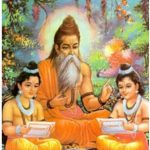One of the mantras which captures, not only the essence of Advaita, but also the Vedas themselves, is Rig Veda 1.164.39 —
“To one who does not know the supreme syllable of the Rig Veda, in which, in heaven, all the devas have taken their seats, what use is the Rig Veda?”
The mantra also appears in Shvetashvatara Upanishad [1]. The Rig Veda gets its name from the type of mantras it contains, known as a ‘ric‘, which literally means “praise”. These mantras focus on invoking and worshipping devas. “To one who does not know the supreme syllable of Rig Veda,” means not knowing what is being worshipped and invoked, the syllable pervading every word of every mantra. The devas take ‘their seats’ in this syllable because it is their source. Knowing this syllable is to know, not only the source of the devas, but also what the entire Rig Veda is in praise (ric) of. Continue reading

